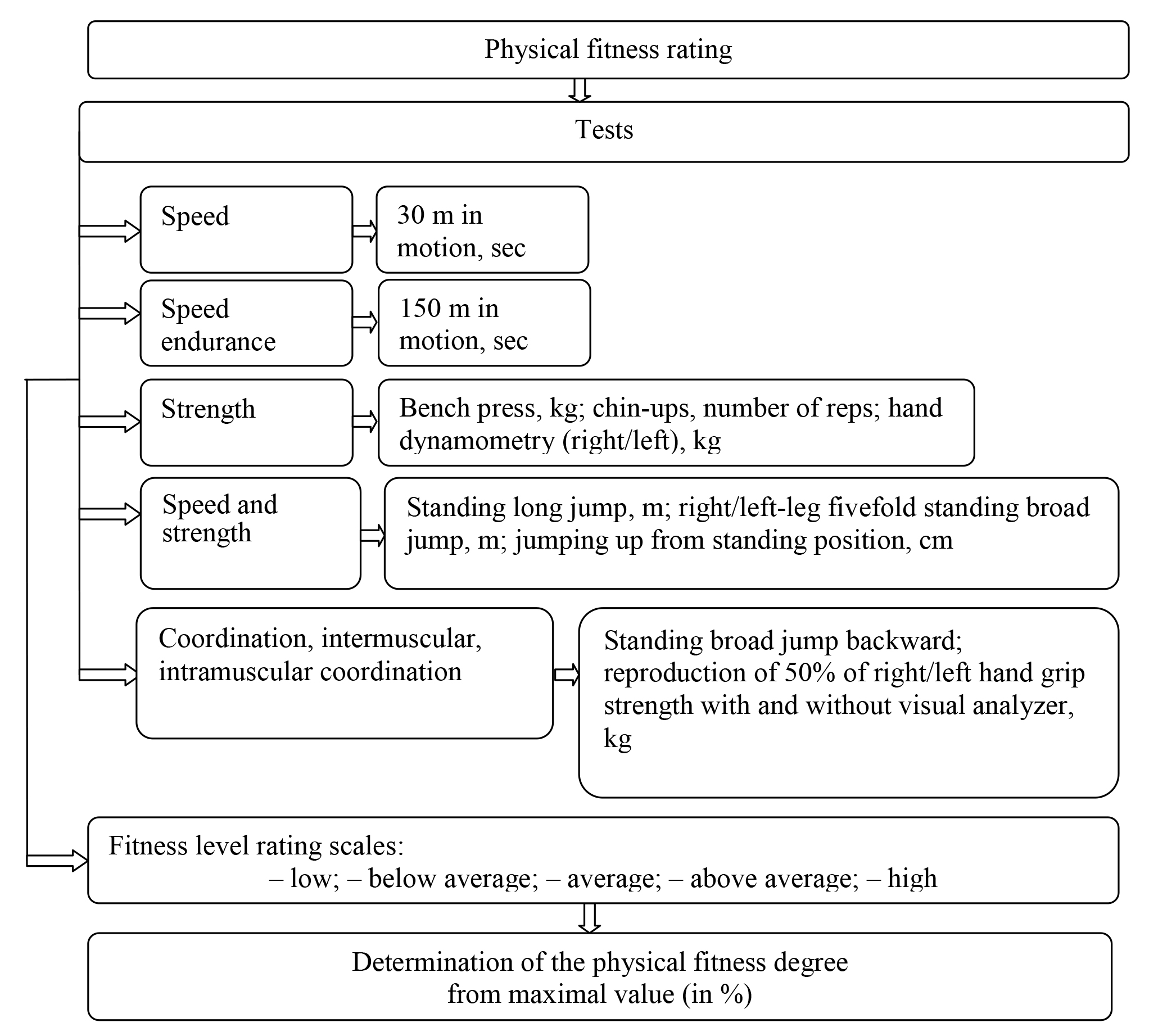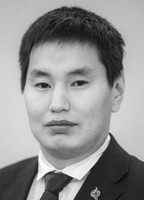Physical fitness tests of highly skilled Muay Thai fighters
Фотографии:
ˑ:
P.P. Okhlopkov1
Dr.Hab., Professor I.A. Cherkashin1
A.G. Migalkin1
M.V. Danilov1
1Ammosov North-Eastern Federal University, Yakutsk
2Churapcha State University of Physical Culture, Churapcha
Keywords: physical fitness, control, test, rate, Muay Thai.
Introduction. The International Olympic Committee provisionally recognized Muay Thai as an Olympic sport on December 6th, 2016. Muay Thai is to be fully recognized and become a part of the Olympics sports program in three years. In this regard, it is important to find ways to improve the training process of Muay Thai athletes. Management of the training process for highly-skilled athletes in elite sport is impossible without improving the organization and procedure of their physical fitness (PF) assessment [2, 5−7]. PF level control in Muay Thai athletes should be carried out in order to identify the dynamics of speed, strength, speed and strength, special and general endurance indicators, which will help us determine the direction of the training process [1, 3, 4]. Works of experts in the field of theory and methodology of training in combat sports are dedicated to their physical fitness rating [1, 2, 4, 7]. However, these studies do not describe the physical fitness rating system of Muay Thai fighters which consists of pedagogical tests and evaluation criteria taking into account sport qualifications and weight category of athletes. It is relevant to develop a physical fitness rating technique for highly-skilled Muay Thai fighters, especially in the context of identifying levels of physical qualities, which determine the predisposition to high sport achievements, forecasting the duration and success of performance throughout athletes' sports careers. Improved physical fitness rating system based on selection of a set of rational pedagogical tests, design of skills-specific rating scales, a testing algorithm without additional use of diagnostic equipment will simplify the control, make it accessible to every coach in the training process, as well as make it possible to obtain the necessary operational data on the current status of athletes aiming at its further correction, a possibility to forecast the scores within the competitive period, determine the levels and structures of athletes’ physical fitness and improve the Muay Thai fighters' qualification process for the national teams of the Sakha Republic.
The research objective was to develop a physical fitness rating technique for highly-skilled Muay Thai fighters.
Research methods and structure. The research methods included analysis and generalization of research and methodological literature, anthropometry, dynamometry, pedagogical testing, educational experiment, mathematical methods of statistics. The study involved 28 First-Class middleweight Muay Thai fighters aged 18-22 years. At first, the data from research and methodological literature related to physical fitness control, pedagogical testing, forecasting in elite sports as well as trainers' practical experience were analyzed and summarized aimed to select test exercises for rating motor capabilities of Muay Thai athletes. Then the athletes were tested using the selected set of tests followed by mathematical and statistical processing of the obtained information to determine the informative tests by means of correlation analysis. Pair correlation analysis of the studied indicators was used to assess the coherence rate between sport skills level and physical fitness parameters of Muay Thai fighters. Thus, tests with medium and high correlation coefficient (r > 0.450 (p<0.01)) were selected. In addition, differentiated scores for rating the physical fitness of highly-skilled Muay Thai fighters were designed, calculated based on the sigmoid functions using the Zatsiorsky's method. Thirdly, a technique for rating physical fitness of highly-skilled Muay Thai fighters was designed and implemented into the training process. The studies were conducted at the premises of the Institute of Physical Culture and Sports under M.K. Ammosov North-Eastern Federal University.
Results and discussion. The analysis of trainers’ practical experience, research and methodological literature and correlation analysis resulted in a number of pedagogical tests selected to rate motor qualities and abilities, differentiated rating scales designed which laid the basis of the physical fitness rating techniques for Muay Thai middleweight fighters. The technique was developed with regard to the following requirements: class and training stage of athletes, accessibility and informative value of the proposed components of the rating technique. Physical tests included in the technique and contributing to a comprehensive assessment of overall physical fitness were split up into five groups depending on their mission: speed abilities, speed endurance, speed and strength abilities, strength abilities and coordination abilities (Figure 1).

Figure 1. Scheme of physical fitness rating technique for highly-skilled Muay Thai fighters
The physical fitness rating technique is about tests being consecutively performed by athletes. They are given one attempt in running tests and chin-ups, three attempts in jumping tests and hand-held dynamometry with the best result fixed in the protocol; in strength tests (bench press) the pressed weight is set by each athlete himself, in each consecutive attempt it is increased by 5 kg until the athlete fails to press a particular weigh. General fitness level is calculated as an integral indicator consisting of the test results in the proposed test groups.
Conclusion. The developed overall physical fitness rating technique for highly-skilled Muay Thai fighters which includes pedagogical tests (their reliability has been proved mathematically) and the estimate indicators of rating scales, is available for use in the training process without any additional equipment, which makes it possible to obtain the necessary operational data on the current status of athletes. Summing up the results of the conducted research, it can be stated that this technique will allow help identify overall physical fitness levels; make corrections to the training session and training plan design; forecast sports scores, duration and success of performance throughout athletes' sports careers; identify at the stages of long-term training the “leaders” among athletes capable of reaching peak performance and subsequently maintain it at further stages; improve the athletic training system for the national teams of the Sakha Republic (Yakutia); improve the system of athletes' qualification to the national team of the Sakha Republic (Yakutia).
References
- Garmaev V.B., Pavlov A.E. Fizicheskaya podgotovka tay-bokserov na etape uglublennoy spetsializatsii [Physical training of Muai Thai boxers at advanced specialization stage]. Vestnik Buryatskogo gosudarstvennogo universiteta, 2015, no. 13, pp. 13-17.
- Priymakov A.A. Sravnitelnaya kharakteristika struktury fizicheskoy podgotovlennosti bortsov vysokoy kvalifikatsii legkikh, srednikh i tyazhelykh vesovykh kategoriy [Comparative characteristics of physical fitness structure of highly skilled light, middle- and heavyweight wrestlers]. Pedagogika, psikhologiya i mediko-biologicheskie problemy fizicheskogo vospitaniya i sporta, 2014, no. 9, pp. 47-53.
- Cherkashin A.V., Krivoruchenko E.V., Skryabin S.P., Okhlopkov P.P. Nauchno-metodicheskoe obespechenie podgotovki sportivnogo rezerva Respubliki Sakha (Yakutiya) [Methodological support of training of sports reserve of Republic of Sakha (Yakutia)]. Teoriya i praktika fiz. kultury, 2015, no. 10, pp. 51-53.
- Khamaganov B.P. Razvitie fizicheskikh kachestv i testirovanie obshchey vynoslivosti tay-bokserov [Development of physical qualities and testing of general endurance of Muai Thai boxers]. Vestnik Buryatskogo gosudarstvennogo universiteta, 2015, no. 13, pp 107-111.
- Khamaganov B.P., Sagaleev A.S. Sistema podgotovki sportsmenov v tayskom bokse [Training system in Thai boxing]. Vestnik Buryatskogo gosudarstvennogo universiteta, 2015, no. 13, pp. 112-116.
- Krivoruchenko O.V. Metodika otsInki fIzichnogo stanu sportsmenIv rIznoYi kvalIfIkatsii, yakI spetsializuyutsya z bIgu na korotkI I serednI distantsIi [Methods of assessing physical condition of sprinters and middle-distance runners of varying skill levels]. PedagogIka, psikhologIya ta mediko-bIologIchnI problemi fIzichnogo vikhovannya I sportu: nauk. Kharkov: KSADM HDADM (HHPI), 2012, no. 5, pp. 83-85.
- Tron R.A., Ilyin V.M., Bitsyura R.V. Kontrol fizichnoy pidgotovlenosti kvalifikovanikh sportsmeniv, yaki spetsializuyutsya u boyovomu sambo [Monitoring of physical fitness of skilled sambo wrestlers]. Pedagogika, psikhologiya ta mediko-biologichni problemi fizichnogo vikhovannya i sportu, 2013, no. 10, pp. 74-77.
Abstract
The article describes a newly developed physical fitness testing model in application to the highly-skilled middleweight Muai Thai fighters. The fitness testing model includes a set of informative and dependable educational/ training process tests to rate fighters’ speed, strength, coordination, speed-strength, and inter- and intra-muscular coordination qualities; with the test rates measured on the relevant scales and presented in percent of the maximal possible rate. The test model presented herein includes 15 test exercises of different types. Practical application of the model in a training process makes it possible to improve efficiency of the training process control and management in Muay Thai; rate physical qualities and abilities; identify natural predispositions of fighters in the bout control styles (typing them as fast boxer, puncher, combined or universal boxer); forecast competitive performance; identify potential leaders; and improve fighters’ qualification system to form teams for competitions of different ranks.



